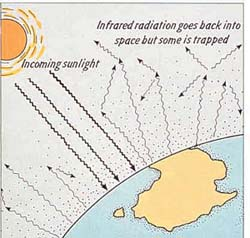 SIRO
scientist Kevin Hennessy, said "Over the last 50 years
Australia has warmed by about 0.8 of a degree Celsius.
SIRO
scientist Kevin Hennessy, said "Over the last 50 years
Australia has warmed by about 0.8 of a degree Celsius.
AVERAGE / EXTREME TEMPERATURES
In Australia the climate is expected to become significantly warmer.
temperatures over most of the continent will rise above 1990 levels by 0.4 to 2º C by 2030,
temperatures over most of the continent will rise by 1 to 6º C by 2070.
On a continent already as warm as Australia, such an increase could have major ecological impacts.
The number of extreme rainfall events – such as those leading to flooding – is also expected to increase
most of the country is expected to become drier overall in the 21st century
http://www.science.org.au/nova/091/091key.htm
Heatwaves and cold snaps
Perhaps the most obvious impact of global warming will be the direct effects: a warmer planet will experience more extreme heatwaves
heatwaves often lead to an increase in the number of human deaths, particularly in temperate countries where people are often not accustomed to very hot weather and where houses and other infrastructure are not designed to cope with it (As seen in Europe in 2003)
The sick and elderly are most vulnerable because their bodies are less able to increase cardiac output and sweat function for cooling purposes; they are often less able to afford cooling technologies.
It is difficult to predict the future effect on mortality levels, because as heatwaves become more frequent we can expect societies to adjust – technologically, behaviourally and physiologically.
Technological adaptations such as the installation of effective air-conditioners and the construction of heat-minimising houses will happen more quickly among the rich, so heatwaves are likely to have a disproportionate effect in less-developed countries and in the poorer segments of rich societies.
Without measures to mitigate the effects of extreme heat, and with an increase in the proportion of older people in the population, we might therefore expect higher death tolls in Australia's future heatwaves. It is estimated that there are currently about 1100 heat-related deaths per year.
Extreme events and disasters
Most computer models generated by scientists indicate that the future climate will be more variable than in the past, and that droughts and floods will be more severe. Some of the health effects of weather-related disasters, in addition to the immediate death and injury to people and damage to property, include:
increases in psychological stress, depression, and feelings of isolation amongst people affected by natural disasters;
decreases in nutrition due to poorer agricultural yields caused, for example, by prolonged drought and problems of food distribution
increases in disease transmission due to a breakdown in sewerage and garbage services. For example, cholera is one disease that thrives in such situations, particularly when flooding causes the contamination of drinking water by sewerage systems.
A2a_s1
Australia's climate is naturally variable, although generally arid.
the implications of an even greater variation in rainfall is likely to be profound.
Apart from the ecological and agricultural impacts, the availability of water may be reduced, with implications for human health.
More frequent drought conditions would increase the risk of bushfires, which can kill people, release large quantities of particulate matter that can cause respiratory problems, and degrade water catchments. http://www.science.org.au/nova/081/081key.htm
Averaged over the entire Australian continent, rainfall has increased over the past 50 years, according to new research by Dr Ian Smith, a climate scientist at CSIRO Atmospheric Research. While many areas over Australia recently have experienced drought, the trend in other areas has been towards wetter conditions. "Unfortunately, the wetter conditions have occurred in the more sparsely populated regions," said Smith.
Rainfall data compiled by the Bureau of Meteorology analysed by Dr Smith shows that rainfall has increased over the summer half of the year in large parts of western, northern and central Australia over the period 1952 to 2002. The subsequent two summers since the analysis was completed have also been relatively wet in those parts of the continent.
"The trends are sufficiently large and widespread to be classified as unusual in a historical context," says Dr Smith. "Furthermore, the wetter conditions may be signs of a changing climate, as foreshadowed by climate experts almost 20 years ago."
The study will be published in the Australian Meteorological Magazine. The trends towards wetter conditions contrast with the long-recognised trend towards drier regional conditions - such as the sudden decrease in rainfall in south-west Western Australia in the mid-1970s, a drying trend over south-east Australia since 1996, and a longer-term drying trend over southern Australia since the 1970s.
In a related research published in Geophysical Research Letters, Dr Richard Wardle of the University of Melbourne and Dr Smith looked at the relationship between increasing summer rainfall and Australia's rising temperature. "Using a climate model we found that forcing the land to absorb more energy causes a complex response whereby the monsoon region becomes wetter and cooler in summer but in the drier regions it becomes wetter and warmer," he says.
"This result is important because it indicates that a regional response to climate change can be very different to the large-scale response. This may be important when interpreting paleoclimate records and is likely to be important when estimating the effects of future climate change," Dr Smith says.
Meanwhile, "Australia has one of the worst records in greenhouse policy in the developed world." according to Frank Muller, a Professor at University of NSW. "The way the science has been heading, we may in our own lifetimes be seeing changes that will make us regret failing to take action earlier." he said.
http://melbourne.indymedia.org/news/2004/11/83101.php#rainfall
A2a_s2
C SIRO
scientist Kevin Hennessy, said "Over the last 50 years
Australia has warmed by about 0.8 of a degree Celsius.
SIRO
scientist Kevin Hennessy, said "Over the last 50 years
Australia has warmed by about 0.8 of a degree Celsius.
fact
a small change in average temperature is associated with quite large changes in extreme temperatures
we then experience increases in the number of hot days and hot nights
we then experience decreases in the number of cold days and frosty nights.
Living in an oven - dire alert for NSW
many parts of NSW will experience many more days with temperatures over 35 degrees
increased bush fire risk
increased extreme weather events
NSW can expect soaring temperatures
a 70 per cent increase in the number of droughts by 2030.
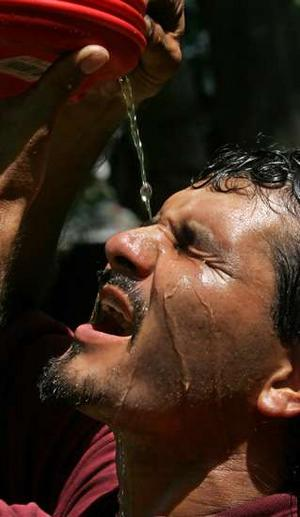 The
Sydney Morning Herald on Monday November 15, lead with an article.' A
CSIRO and BOM report produced by Kevin Henessy and other scientists
The
Sydney Morning Herald on Monday November 15, lead with an article.' A
CSIRO and BOM report produced by Kevin Henessy and other scientists
Average days above 35 degrees
|
Town |
Now |
2030 |
2070 |
|
Wilcannia |
59 |
83 |
136 |
|
Cobar |
41 |
65 |
128 |
|
Walgett |
56 |
87 |
153 |
|
Gunnedah |
19 |
40 |
103 |
|
Yamba |
1 |
2 |
7 |
|
Bathurst |
4 |
11 |
43 |
|
Sydney |
3 |
6 |
18 |
|
Moruya |
2 |
3 |
6 |
|
Canberra |
5 |
13 |
42 |
|
Wagga |
20 |
34 |
78 |
|
West Wyalong |
26 |
42 |
93 |
|
Deniliquin |
24 |
37 |
75 |
*Max
of range in worst scenario - Source CSIRO, BOM
The New South Wales Premier, Bob Carr, presented the CSIRO/BOM report to the International Taskforce on Climate Change meeting in Sydney. Bob Carr said "This is deadly serious and it's upon us. Global warming has got New South Wales in its grip as much as any other part of the world. We face these terrible increases in average climate. Parts of our State are already very hot, but if you look at where they're going to be by 2012 and then after 2030, is really going to be living in an oven."
A2a_s3
"The most extreme rainfall events we currently experience become more frequent in 2040, with the 1-in-40 year event of today corresponding with a 1-in-15 year event in future," said Dr Debbie Abbs, a climate scientist at CSIRO Atmospheric Research in Melbourne.
"The areas of greatest increase in intensity occur over mountainous terrain, inland from Coffs Harbour, Coolangatta and north of Brisbane."
Each year extreme rainfall events cause significant damage, as a result of flooding, in the highly urbanised regions along Australia's eastern coastline where population is increasing. Dr Abbs says that a 26% increase in flooding leads to a 60% increase in damage costs. "With projected increases in the intensity and frequency of extreme precipitation events, the community's exposure to extreme rainfall events is growing rapidly," says Dr Abbs.
"Global climate models simulate rainfall over areas as wide as 200 kilometres. Extreme rainfall over small areas is much more than that found over large areas where results are averaged out," said Dr Abbs. Dr Abbs was presenting her research at the Australia New Zealand Climate and Water Forum in Lorne, Victoria
Averaged over the entire Australian continent, rainfall has increased over the past 50 years, according to new research by Dr Ian Smith, a climate scientist at CSIRO Atmospheric Research. While many areas over Australia recently have experienced drought, the trend in other areas has been towards wetter conditions. "Unfortunately, the wetter conditions have occurred in the more sparsely populated regions," said Smith.
Rainfall data compiled by the Bureau of Meteorology analysed by Dr Smith shows that rainfall has increased over the summer half of the year in large parts of western, northern and central Australia over the period 1952 to 2002.
"The trends are sufficiently large and widespread to be classified as unusual in a historical context," says Dr Smith. "Furthermore, the wetter conditions may be signs of a changing climate, as foreshadowed by climate experts almost 20 years ago."
The trends towards wetter conditions contrast with the long-recognised trend towards drier regional conditions - such as the sudden decrease in rainfall in south-west Western Australia in the mid-1970s, a drying trend over south-east Australia since 1996, and a longer-term drying trend over southern Australia since the 1970s.
In a related research published in Geophysical Research Letters, Dr Richard Wardle of the University of Melbourne and Dr Smith looked at the relationship between increasing summer rainfall and Australia's rising temperature. "Using a climate model we found that forcing the land to absorb more energy causes a complex response whereby the monsoon region becomes wetter and cooler in summer but in the drier regions it becomes wetter and warmer," he says.
"The way the science has been heading, we may in our own lifetimes be seeing changes that will make us regret failing to take action earlier." he said. http://melbourne.indymedia.org/news/2004/11
A2a_s4
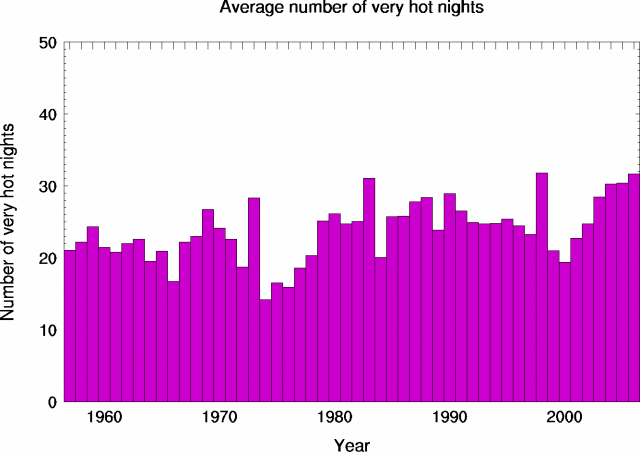 Australian
Climate Extremes
http://www.bom.gov.au/cgi-bin/silo/reg/cli_chg/extreme_timeseries.cgi
Australian
Climate Extremes
http://www.bom.gov.au/cgi-bin/silo/reg/cli_chg/extreme_timeseries.cgi
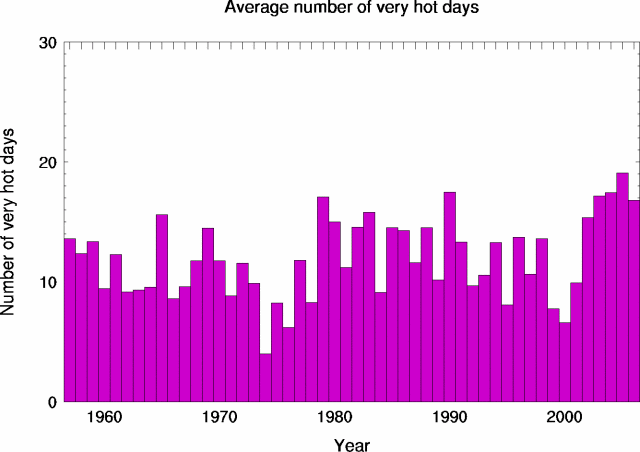
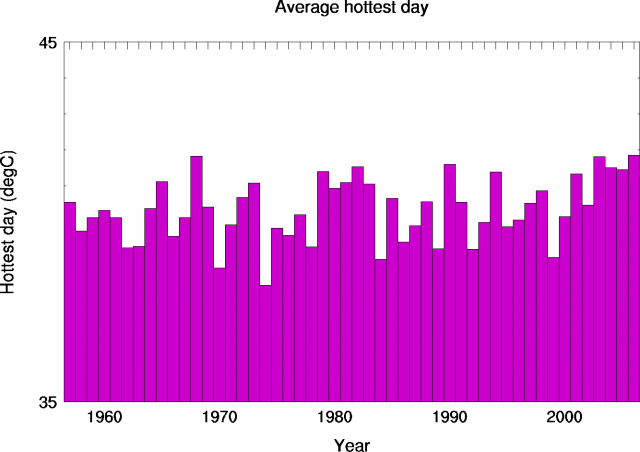
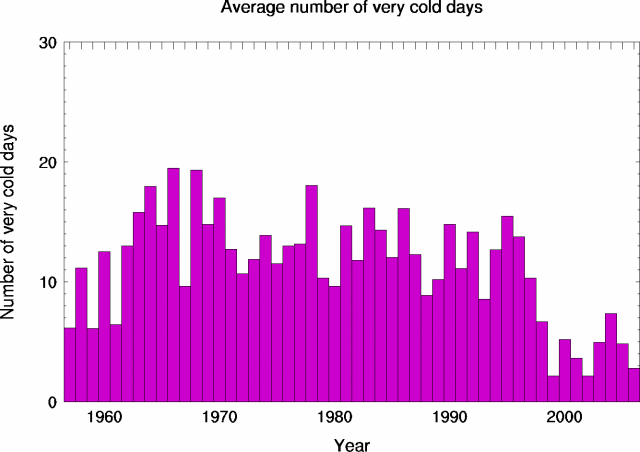
A2a_s5